Bees are known for their role in honey production and cross-pollination. However, species like carpenter bees are notorious for boring into wood, proving destructive if not controlled early enough. So how can you get rid of carpenter bees and prevent them from drilling holes when nesting?
How to get rid of carpenter bees? Purchase or make a trap, then hang it right above the beehive. Bees will fall into the trap thinking it is a nest and become stuck within, unable to leave. Solutions of water with citrus oil or almond oil are non-toxic liquids that deter bees. Dusting and plugging the holes will also help prevent an infestation.
If you have a carpenter bee problem, then you’re in the right place! Let’s get started! This article will discuss everything you need to know about carpenter bees and how to prevent these essential pollinators but destructive pests from damaging your property.
What Are Carpenter Bees?
Also called borer bees, carpenter bees are named after their burrowing behavior as they prefer to nest in deadwood. While these pests won’t eat wood, they can cause damage to wooden structures when drilling their circular holes.
Unlike other bees that live in colonies, carpenter bees prefer building individual nests in trees, eaves, or frames of buildings.
What Does a Carpenter Bee Look Like?
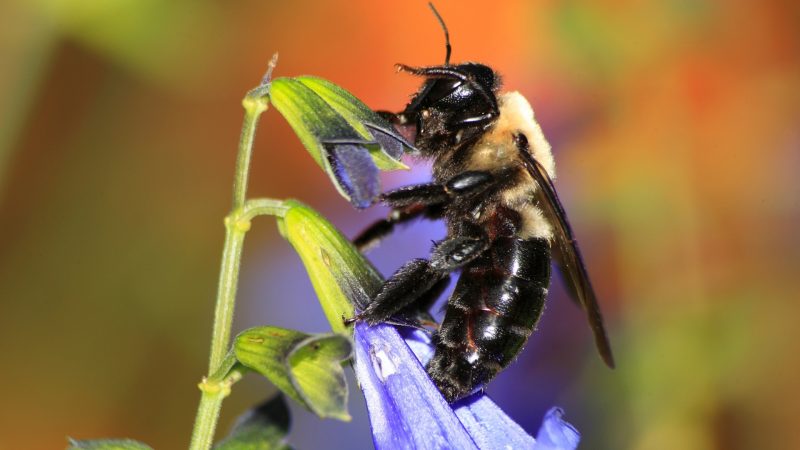
Carpenter bees are characterized by their smooth and shiny abdomens. Although frequently confused with bumblebees, they usually have a black, fuzzy yellow front end.
Most male carpenter bees will have a cream or white-colored dot centrally located on the head. However, it’s important to note that their physical appearance might vary depending on the species.
How Long Do Carpenter Bees Live?
Unlike their bumblebee or honeybee cousins who have short lifespans, carpenter bees tend to live long. According to a study by the University of Kentucky College of Agriculture, carpenter bees can live for up to three years, with each female hatching one or two generations annually.
Related: How Long Do Bumblebees Live?
Where Do Carpenter Bees Live?
Unlike bumblebees and honeybees that live in colonies, carpenter bees prefer living alone. These bees get their name from their habit of boring wood when preparing their habitats. Carpenter bees fancy living inside trees, on the frames and eaves of houses, and on isolated wooden objects.
What Do Carpenter Bees Eat?
Carpenter bees eat nectar and pollen, which they obtain from plants. However, contrary to popular belief, these insects don’t eat wood. Instead, they bore into dead wood as a way of nesting. This means you’re likely to find carpenter bees in areas with pollen and nectar.
Related: What Do Wasps Eat?
Types of Carpenter Bees
There are several species of carpenter bees that exist in the US. These are:
- Southern carpenter bees: Mostly found in the coastal regions of the Southeastern US, Guatemala, and Mexico and aren’t as destructive as other carpenter bees.
- Eastern carpenter bees: Characterized by their black, glossy bodies that have a purplish tint.
- Sonorina carpenter bees: Also called Hawaiian carpenter bees, the Sonorina carpenter bee is mostly found in northern California and western Texas.
- Horsefly-like carpenter bees: Primarily found in Central, North and South America, horsefly-like carpenter bees are slightly larger than most carpenter bees.
- California carpenter bees: Mostly found in California, Nevada, Utah, and Washington. California carpenter bees are highly active when hot.
Are Carpenter Bees Dangerous?
Carpenter bees can be dangerous if threatened. And although they don’t live in colonies, female carpenter bees can sting in self-defense when attacked.
Do Carpenter Bees Sting?
Female carpenter bees come with stingers designed to provide protection when under threat. And while they can sting more than once, the good news is they only sting when threatened. Male carpenter bees are more aggressive than their female counterparts but lack stingers, rendering them harmless.
Are Carpenter Bees Aggressive?
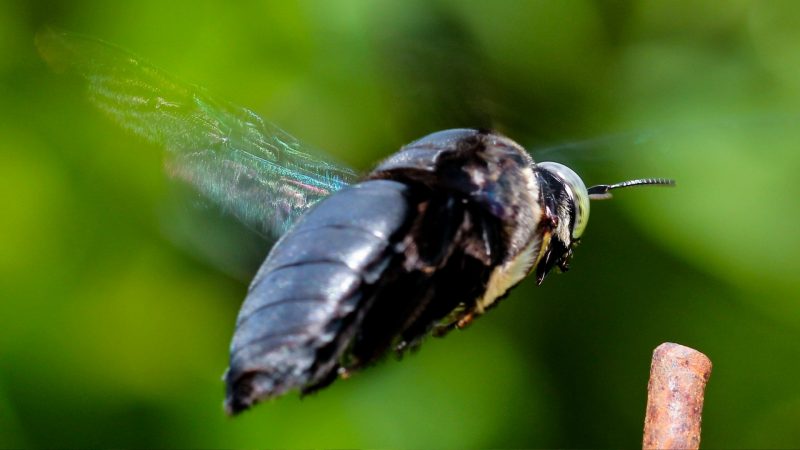
Although not as aggressive as other types of bees, carpenter bees, more so the males, can become aggressive when threatened. Their aggression greatly depends on the amount of provocation. Female carpenter bees won’t hesitate to sting if threatened. However, male bees will attempt to fly close to the threat as a form of warning.
What Attracts Carpenter Bees?
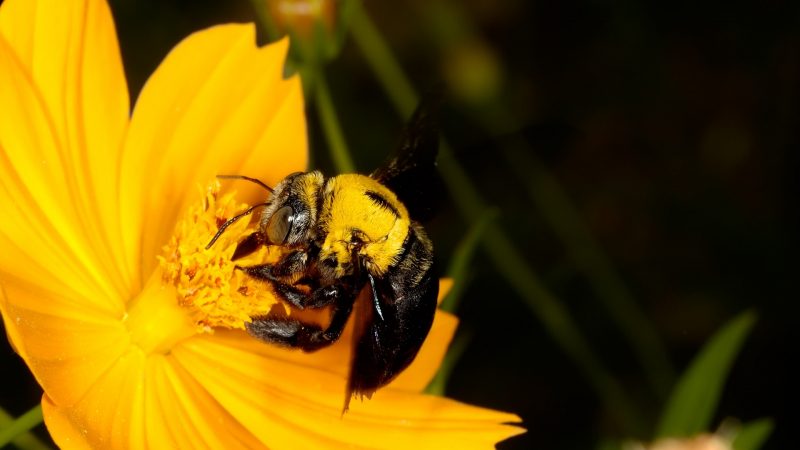
Carpenter bees are attracted to the following items listed below:
- Untreated wood
- Flowers
- Older carpenter bee nests
- Wood siding
- Unprotected plank ends
Why Do Carpenter Bees Drill Holes in My House?
Carpenter bees emerge in the spring in search of a mate. A female begins constructing a house by digging a hole with her extraordinarily powerful mandibles after mating.
About a half-inch is drilled into the wood before she turns and continues tunneling perpendicular to the wood’s grain. Each tunnel she builds will take more than a month to complete. These brood chambers are where she gradually plans to lay eggs.
Signs of Carpenter Bee Infestations
Carpenter bees create holes that are about half an inch across. Although they prefer bare wood, they can drill through softwood and rotting wood to form tunnels. Wood that has already sustained damage results in frass. Around the drilling locations, there appears to be sawdust.
Carpenter bee females enlarge the main passage in wood, often known as a channel. The female lays her eggs in places called “galleries” or “cells”, and the damaged area will range in size from 6″ to as long as 4 feet.
She places eggs in these galleries and supplies the developing larvae with a lot of pollen to eat. Prior to starting the next egg phase, she closes them off to guarantee their growth. This is one of the factors that contribute to the difficulty of eliminating carpenter bees.
How Do You Get Rid of Carpenter Bees? Step by Step Instructions

Spray With Insecticides
If you choose to use chemicals to control carpenter bees, consider observing the following steps below:
Step 1: Identify the affected areas. For best outcomes, it’s advisable to prioritize spraying the affected areas. So check on areas in your home or yard with carpenter bee borrowings from decks to overhangs, fence posts, fascia boards, sidings, and even window frames. Understanding the areas, you’re working on will allow you to determine the amount of insecticide needed.
Step 2: Choose your preferred products. You can choose to buy carpenter bee pesticides online or from a local brick-and-mortar store. Some quality products you can find on Amazon include CYZMIC CS Insecticide. Ensure you buy the products in large amounts, especially if dealing with potentially large infestations.
- Effective Against: ants, cockroaches, mosquitoes, silverfish,...
- Active Ingredients: 9.7% Lambda-Cyhalothrin
Step 3: Observe the dilution instructions and spray. Before spraying the affected areas, it’s crucial to observe the instructions provided on the insecticide container. Once you’ve achieved the correct dilution rates, proceed to spray the affected areas.
Something to note, though, you might have to spray more than once a month, especially if dealing with large infestations during carpenter bee season.
Apply Insecticide Dust and Plugging Holes
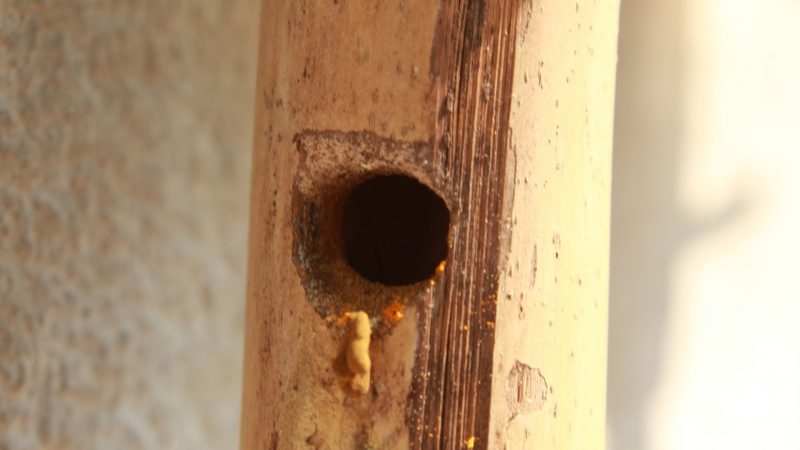
Applying insecticide dust and filling the holes is another great way to eliminate carpenter bees. Below are steps to observe when applying insecticide dust:
Step 1: Fill a hand duster with your preferred dust. For this method to work, it’s important to use a quality hand duster. Then, fill it three-quarter-way with proven carpenter bee dust like Bayer DeltaDust Insecticide, which is 100% waterproof.
- Target Pests: Ants, Bedbugs, Cockroaches, Fleas, Silverfish,...
- For use In: Residential & Commercial, Cracks & Crevices Indoors...
- Shelf life: Delta Dust will last for up to 3 years when stored in...
- Always read and follow actual package for complete label...
Step 2: Dust into all holes. While it might be hard to fill all individual galleries, try to dust as many holes as possible. As a rule of thumb, you should dust the holes in the evening or nighttime (if you have proper lighting) as you’ll be guaranteed to find the mother present.
Step 3: Fill the holes. Most experts recommend caulking or filling the holes around two weeks after applying the dust. When sealing the holes, you can use products like Gorilla Waterproof Patch & Seal Tape to prevent access to the potential nesting ground.
- PERMANENT: Creates a permanent bond that instantly seals out air,...
- INDOOR / OUTDOOR USE: Gorilla Waterproof Patch & Seal tape works...
- EXTRA THICK: Has an extra thick adhesive layer and UV resistant...
- FLEXIBLE: Conforms to the surface to repair holes, cracks, gaps,...
- FIXES LEAKS: Repairs leaks in roofs, rubber, plastic or vinyl...
How Do To Get Rid of Carpenter Bees in Specific Places?
Here’s how to get rid of carpenter bees in different locations in your home or yard:
How To Get Rid of Carpenter Bees in Your House?
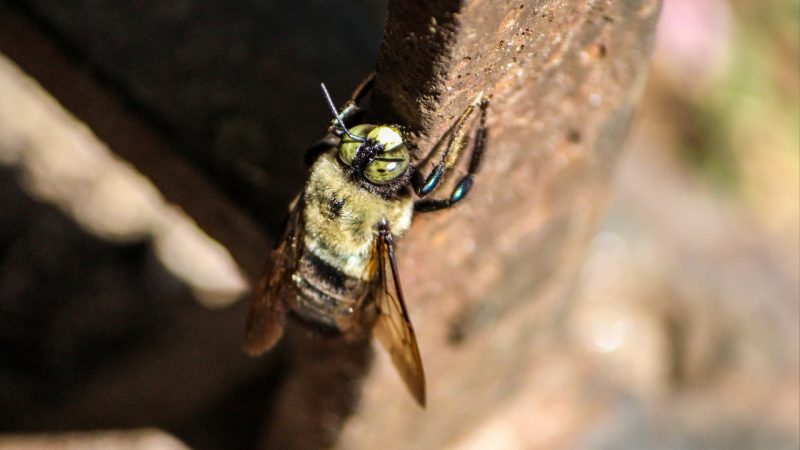
If you’re dealing with a mild infestation inside the house, you might want to spray a solution of citrus fruits, which is non-toxic and suitable for home use. Boil citrus fruits like lemon, lime, and orange, then place the solution in a spray bottle before targeting the infested areas.
How To Get Rid of Carpenter Bees Around the House?
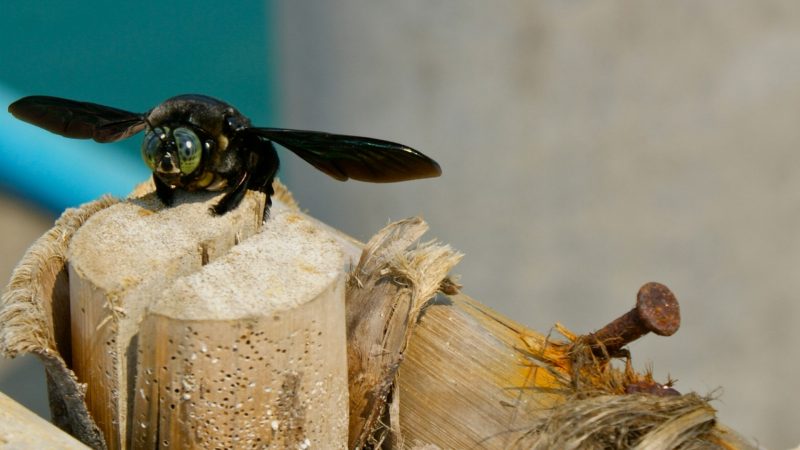
Carpenter bees around the house can be eliminated by either spraying natural solutions or chemicals to control the population. You can also play loud music close to the nesting ground to make the bees extra uncomfortable as they don’t fancy loud noises.
How To Get Rid of Carpenter Bees in Attic?
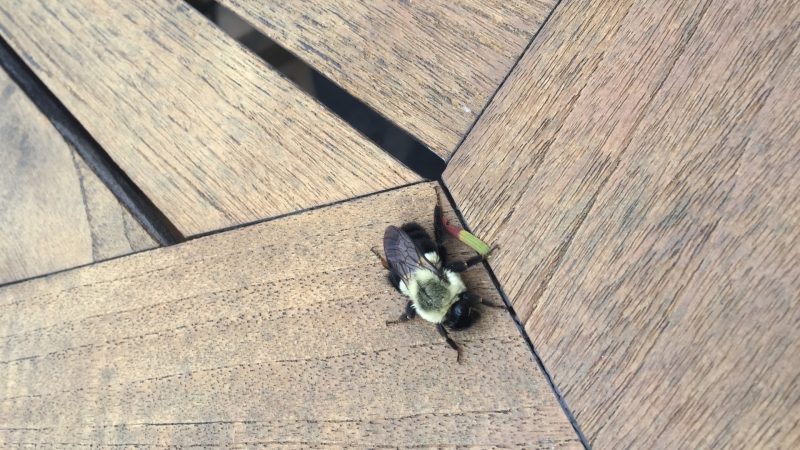
It’s highly advisable to use natural methods to eliminate carpenter bees inside the house. In addition to using a citrus solution, you can also spray almond oil or essence strategically around the nest in the attic. This will help repel the bees.
How To Get Rid of Carpenter Bees in Walls?
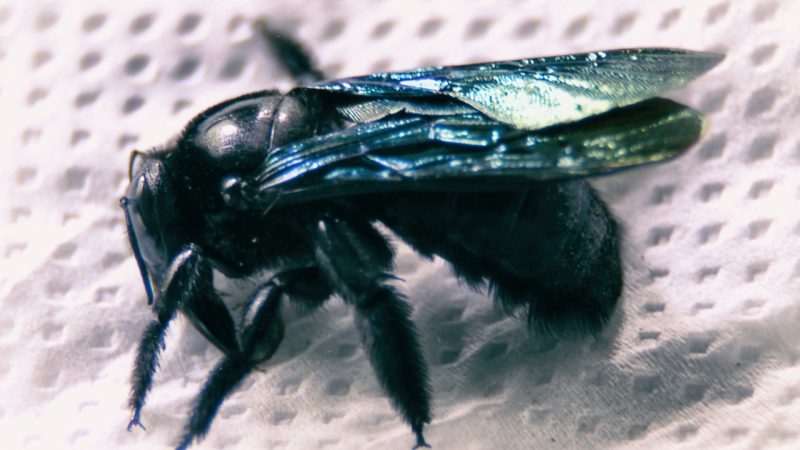
If dealing with exterior walls, it might be advisable to use proven insecticides like the Syngenta Demon WP Insecticide, which tends to work fast for longer. Additionally, applying dust like Drione Pest Insecticide Dust will also help to eliminate carpenter bees in walls.
- Active Ingredient: Cypermethrin 40% Yield: One envelope...
- Target pests: ants, carpenter ants, cockroaches, crickets,...
- Application: Demon WP leaves a white powdery film that is...
- Can not be shipped to NY or CT
- Kills up to 6 months when left undisturbed
- Non-staining and relatively odorless
- For use in residences, institutions, food plants and granaries...
- Excellent penetration into voids
- Target pests include but not limited to: Ants, bedbugs, bees, box...
How to Get Rid of Carpenter Bees Under Shed?
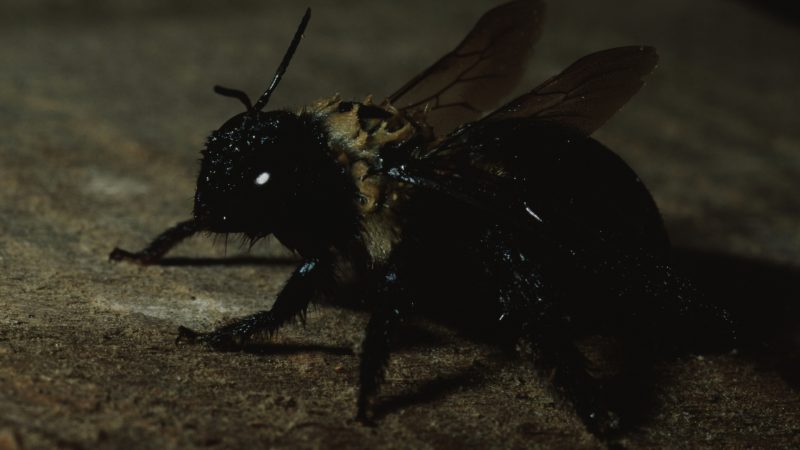
To get rid of carpenter bees under the shed, you can use organic methods, chemicals, or even a trap, depending on the items you have in the shed. However, since sheds can become serious breeding grounds, it’s best to apply dust to prevent larvae from reproducing.
How To Get Rid of Carpenter Bees Nest?
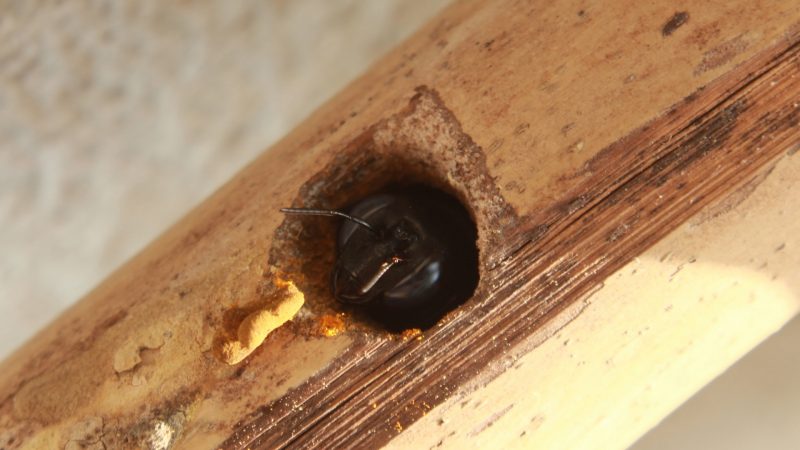
You can get rid of a carpenter’s bee’s nest by making the conditions unsuitable for the bee. However, if dealing with large infestations, it’s best to reach out to a trusted bee removal service provider. Either way, it’s advisable to put on a complete bee suit when working on massively infested nests.
What Keeps Carpenter Bees Away?
You can use several methods or techniques to keep carpenter bees away, as explained below.
Carpenter Bee Traps
Using traps is a great way to control the population of carpenter bees without having to use chemicals, dust, or organic solutions. The traps will work well if positioned close to wooden surfaces or trees where carpenter bees are likely to nest.
Carpenter Bee Sprays
Carpenter bee sprays also work, especially when sprayed on affected areas. However, when using sprays, it’s important to ensure you use the right quantities to cover all the infested areas. The Spectracide Carpenter Bee Killer is an example of a fast-acting spray that kills carpenter bees on contact.
No products found.
Carpenter Bee Repellents
It’s advisable to use carpenter bee repellents if you don’t want to kill or harm the bees. Some common repellents include citrus solution and almond oil. The scent of these repellents is enough to keep carpenter bees away. However, you might need to apply repellents frequently to keep carpenter bees completely off your property.
Related: Do Dryer Sheets Repel Bees?
Carpenter Bee Insecticides
When dealing with potentially large infestations, you might have to use carpenter bee insecticides like dust and even chemicals. The BioAdvanced 700420A Termite & Carpenter Bee Killer Plus Pesticide is an example of a quality insecticide that can be used to treat hard-to-reach areas. When using insecticides, it’s best to target the holes and neighboring areas to ensure the bees have no escape route.
- TERMITE KILLER: Kills the termites you see, and the ones you...
- INSECT KILLER: Plus kills other wood-infesting insects including...
- FOAM SPRAY: The foam expands at a 30:1 ratio to fill cracks
- EASY APPLICATION: Do it like the pros do- get the hard-to-reach...
How To Get Rid of Carpenter Bees Naturally?
Some of the ways to get rid of carpenter bees naturally include:
- Setting traps
- Placing wasp nests to act as a decoy
- Playing loud music close to the nest
- Using organic repellents
- Filling abandoned holes
- Use a racket to hit them
- Dress exposed wood
Natural Carpenter Bee Repellents
Carpenter bees don’t fancy the smell of citrus or almonds. So, if you want to repel these bees naturally, you should consider placing citrus or almond oil in spray bottles and spritzing on the holes and affected areas. Playing loud music close to a nest is also a great way to repel carpenter bees.
- GMO Free Plant Extracts: Natural derivatives from plant sources,...
- Key Benefits: Fresh fruity scents can fresh air, soothe and relax...
- No Artificial Fragrances: Compatible with aroma diffuser or...
- Scented Gift Ideas: This essential oil set is suitable as a gift...
- Versatile-Use: Our essential oil set can be used to create...
- Premium Grade Almond Fragrance Oil – (0.33 fl oz/10 ml) It’s...
- Controlled Drips – Each Good Essential oil bottle features an...
- Uses – Easily blend with a carrier oil to make body oil or hair...
- Handmade Gifts – Improve DIY projects with the scent of sweet...
- Bottled in The USA – We use the highest quality oils and test...
How To Make a Carpenter Bee Trap?
A carpenter bee trap is a proven way to control carpenter bees and prevent them from infesting different parts of your home. If you’re looking to build a DIY bee trap, then you should observe the following steps below:
Step 1: Choose and cut a piece of lumber. Choose a large enough size of untreated wood, preferably cedar or pine, and cut it in such a way that it has a rectangular shape, with all sides attached (roof and base included).
Step 2: Drill the base hole. Create a tunnel for the carpenter bees to transition from the wood to the jar. Ideally, the hole should measure more than ½ in (1.27 cm).
Step 3: Drill the side holes. Side holes create several entry points for the targeted bees. Using the same-sized drill, create three to five separate holes (depending on the size of the lumber) that drive toward the center hole.
Step 4: Make a hole in a Mason jar and attach it to the base. Drill a hole at the center of your Mason jar’s lid and carefully nail it to the base of the trap. If you plan to add sugar water or honey, be sure to do so before screwing the jar onto its lid.
Step 5: Hang the trap. It’s best to hand the trap straight and in a strategic location where it’ll be noticed by the carpenter bees.
How To Keep Carpenter Bees Away?
To keep carpenter bees away, it’s best to prevent the larvae from reproducing in the nest. This means applying dust and spraying the holes and affected areas as frequently as possible. You might also need to set up carpenter bee repellents in strategic locations to prevent them from nesting in your home or yard.
Related: How To Get Rid of Bumblebee, Bumblebee Nests, and Stings?
List of Sources
Rankin, D. (2007). The Pollinators: Carpenter Bees. Galveston County Master Gardeners.
Jacobs, S. (2017). Carpenter Bees. PennState Extension.
Jones, S. C. (2017). Carpenter Bees. Ohio State University Extension.
Waldvogel, M., Alder, P. (2018). Carpenter Bees: Biting and Stinging Pests. NC State Extension Publications.
- How to Get Rid of Cockroaches? | Proven Strategies & Solutions! - June 24, 2023
- Powerful Homemade Wasp and Bee Sprays (with Recipes) - March 4, 2023
- Crazy Ants Invasion | Eradicate & Prevent Unwanted Guests - February 24, 2023









